
Psoriasis is a pathology in which the human immune system mistakenly attacks healthy skin cells. As a result, scaly plaques appear on its surface that can be very itchy and even painful. Sometimes the disease is accompanied by inflammation of the joints and eyes.
What is psoriasis
Psoriasis is a chronic autoimmune disease that causes red, scaly patches on the surface of the skin. They are often called plaques.
Psoriasis is not contagious - it is an autoimmune disease, not an infectious disease.
Psoriasis is manifested by inflammation of the skin, as well as abnormally rapid growth and peeling of cells (keratinocytes) that make up the stratum corneum - epidermis. Usually, it is completely restored within a month, but in people with psoriasis, this process is accelerated several times and takes place in an average of 3-4 days.
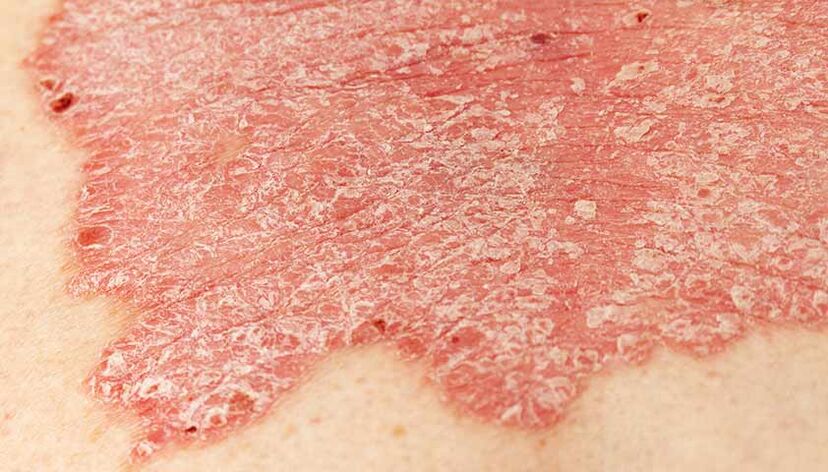
In addition to skin damage, the disease also causes joint inflammation (in about 30% of cases). Somewhat less often - in 10% of cases - psoriasis leads to inflammation of the uvea (uveitis).
Prevalence of psoriasis
Psoriasis most often affects people between the ages of 15 and 35, but in general the disease can appear at any age. The first peak of pathology occurs at the age of 15-20, the second at 55-60.
On average, psoriasis affects approximately 1-2% of people worldwide. In our country, according to the clinical recommendations of the Ministry of Health, in 2021 the prevalence of the disease was 243. 7 cases per 100, 000 inhabitants.
Types of psoriasis
Like many chronic diseases, psoriasis differs in stages, severity and form of manifestation.
By phase
Psoriasis has three stages: progressive, stationary and regression (remission).
INprogressive phasered spots appear on the skin. Joining together, they form large scaly plaques with a pronounced red outline around the edges - it is called erythematous erythema Redness on the skin caused by capillary dilation and blood flow. corolla, or corolla. New plaques are very itchy and can hurt.
Traumatized areas of the skin are particularly susceptible to the appearance of new spots: a psoriatic plaque can quickly develop at the point of friction (for example, on clothing), as well as in the area of a scratch or scratch. Doctors call this phenomenon the Koebner phenomenon.
This phenomenon, also known as "isomorphic reaction", was discovered by the German dermatologist Heinrich Koebner in 1872. The doctor noticed that some patients with psoriasis develop new plaques on the skin at places of trauma, for example after scratches, injections or bruises.
Stationary stage- stabilization phase. Plaques stop growing, but continue to bother and peel. New rashes and spots usually do not appear.
Regression phaseoccurs when the symptoms of psoriasis begin to disappear. Peeling disappears, plaques lighten and flatten. Symptoms decrease in this phase.
By severity
To assess the severity of psoriasis, doctors use the PASI (Psoriasis Area and Severity Index) system - an index for assessing the severity and prevalence of psoriasis. It requires a professional analysis of parameters such as the severity of erythema, infiltration, peeling and calculation of the skin surface affected by the rash.
Depending on the results of the examination, doctors distinguish mild, medium and severe degrees of the disease.
According to the form
According to the clinical picture of the manifestations, several main forms of psoriasis are distinguished: vulgar, inverse, seborrheic, exudative, guttate, pustular, psoriasis of the palms and soles and psoriatic erythroderma.
Vulgar (ordinary) psoriasis- one of the most common forms, which accounts for about 90% of all cases of the disease. First, red spots appear on the skin, which in a few days turn into convex, scaly plaques. As the plaques develop, they coalesce into large, itchy, scaly lesions. Then the condition enters the phase of stabilization and regression: the manifestations of the disease temporarily recede and the person's well-being improves.
The most common places where psoriasis vulgaris appears are the extensor (external) part of the skin of the elbows and knees. Lesions also appear on the body and scalp.
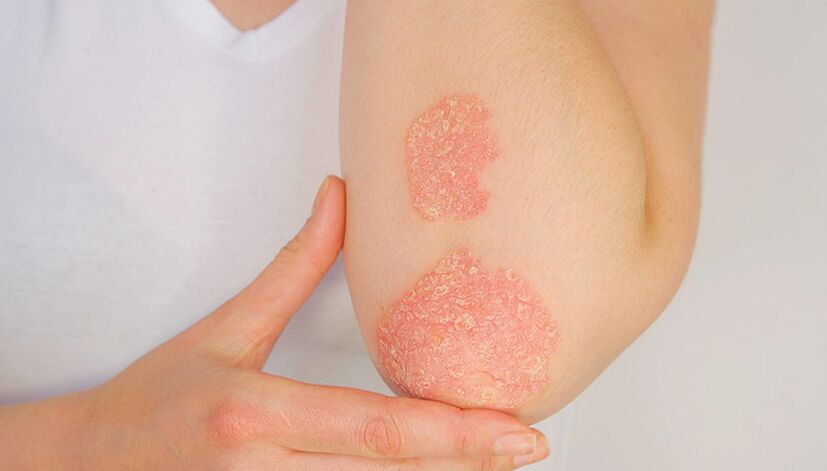
Psoriasis vulgaris on the outer part of the elbow
Inverse ("reverse") psoriasiscontinues in the same way as usual. The only difference is in the location of the lesions: they do not appear on the extensor (outer) part of the knees and elbows, but on the flexor (inner) part - that is, under the knees, under the armpits and in the elbow area, as well as on the neck, eyelids, navel, inguinal folds. The skin in these places is more delicate, moist and often rubs against clothes. Because of this, it may itch more than in the usual form of the disease, but the peeling in those places is less pronounced.
Seborrheic psoriasisit takes place in the same way as normal, but its foci are located in places with a large number of glands that secrete sebum. It is the scalp, folds behind the ear, cheeks and nasolabial part of the face, forehead, chest and back (mainly the upper part).

Seborrheic psoriasis on the scalp
Exudative psoriasis- a type of disease in which, in addition to peeling, exudate also appears in the lesion. It is a fluid that contains proteins, some blood cells, and other substances. Exudate can be released from capillaries during inflammation.
The crust on the surface of the plaques in the exudative form of the disease is usually thick, grayish-yellow, and sometimes slightly moist. This type of psoriasis most often occurs in people with endocrine disorders: thyroid pathology, type 2 diabetes mellitus or obesity.
Guttate psoriasisIt does not appear as plaques on the skin, but as numerous papules - swollen spots of bright red color with peeling in the middle. The size of the papules can vary from approximately 1 to 10 mm. They cover mainly the torso, arms and legs.
Guttate psoriasis usually occurs in children after a streptococcal infection (for example, tonsillitis). It is treated a little better than other types of psoriasis, but in some cases it can turn into a common (vulgar) form.
Pustular psoriasischaracterized by the appearance of multiple pustules on a red erythematous background. Pustules are formations that look very similar to pimples. Such psoriasis can be the result of infectious diseases, stress, hormonal imbalance, improper use of drugs or inadequate use of fats. Initially, numerous pustules appear on the red spots. They then merge into one large pus point (or "pus lake").
The generalized form of pustular psoriasis is difficult to tolerate: with episodes of fever, weakness, as well as severe pain and burning of the skin. At the same time, changes in the nails and pain in the joints can be observed.
Psoriasis of the palms and soles- typical psoriatic rashes appear in the area of the palms and soles, they occur less often in the form of localized pustular psoriasis. It can also affect and deform the nails - they become thicker, cloudy and uneven.
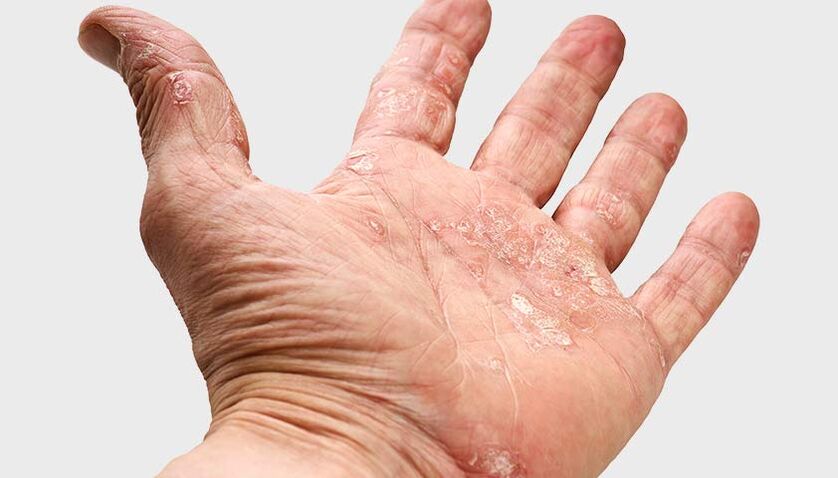
Psoriasis on the palm
Erythrodermic psoriasisIt is quite rare and is considered an extremely severe form of the disease. Redness occurs on about 90% of the body, severe itching and pain occur, the skin swells and peels. The temperature often rises and the lymph nodes become inflamed.
Typically, this type of psoriasis is the result of an exacerbation of another form of the disease due to improper treatment or unfavorable environmental factors (for example, sunburn in advanced psoriasis vulgaris, inadequate use of irritating external agents or intravenous glucocorticosteroids).
Symptoms of psoriasis
Manifestations of psoriasis vary depending on the type of disease and its severity.
Common symptoms and signs of psoriasis:
- red, raised, scaly patches on the skin;
- itching in the area of inflammation and peeling;
- changes on the nails: precise prints, thickening and crumbling of the plate, its separation;
- joint pain (sometimes).
For an accurate diagnosis, it is necessary to contact a specialized specialist - a dermatologist.
Mechanism of psoriasis development
Psoriasis is an autoimmune disease.
All autoimmune pathologies are associated with an error in the functioning of the immune system. It usually "scans" the body 24 hours a day and looks for pathogen cells using foreign protein molecules that distinguish them from the "normal" cells inherent in the body.
As soon as foreign protein molecules are detected, the immune system activates special immune cells - T-lymphocytes, which must destroy the enemy.
But for some people, the friend-foe recognition system can go haywire. As a result, the immune system begins to attack healthy cells of certain organs or tissues, causes inflammation in their places and in every possible way damages the body, which, in fact, it should protect.
This is what happens in psoriasis: the immune system attacks the skin. It activates T-lymphocytes and "places" them on skin cells. Reaching the goal, T lymphocytes release substances that cause inflammation - cytokines. They cause the first symptoms: redness, swelling, itching and pain.
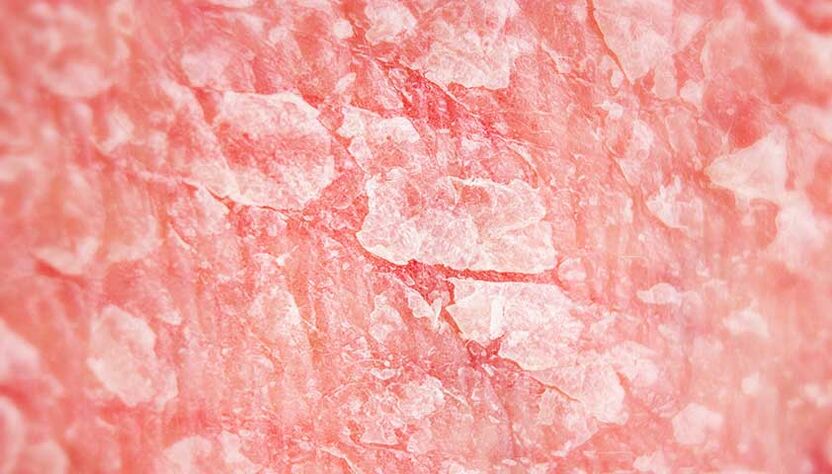
In psoriasis, skin cells divide several times faster, resulting in scales and flaking.
Under the influence of cytokines, an inflammatory process develops, and skin cells begin to actively divide - this is how active peeling occurs and a convex plaque is formed.
Since the cell renewal process is accelerated almost ten times, the main cells of the epidermis (keratinocytes) do not have time to form properly. Therefore, they cannot perform their barrier function.
As a result, the stratum corneum becomes permeable and stops protecting the deeper layers of the skin from the environment and moisture loss. All this leads to even more inflammation.
Until the immune system calms down, the disease will progress and the symptoms will intensify.
Causes of psoriasis
The exact reasons why psoriasis develops are not yet fully understood. However, many studies agree that the development of psoriasis is related to genetics, as well as lifestyle, co-morbidities and adverse environmental factors.
Genetics
The disease is often inherited from parents to children. Psoriasis is mostly associated with the HLA-C gene. It encodes a protein that allows the immune system to recognize its own (harmless) cells.
In patients with psoriasis, doctors more often than in other people detect a special genetic marker in the HLA-C gene - HLA-Cw6. However, its presence only indicates a predisposition to the disease. Not all people with the HLA-Cw6 marker necessarily have psoriasis, and not all patients diagnosed with this disease have this genetic change.
Lifestyle
It is believed that constant damage to the skin, frequent friction, sunburn and hypothermia can be triggers for the development of the disease. Especially if there is a hereditary predisposition in the form of the genetic marker HLA-Cw6 or close relatives suffering from psoriasis.
Other risk factors are constant stress, alcohol abuse, and smoking - all of which have a detrimental effect on metabolism, the functioning of internal organs, and the immune system.
Accompanying pathologies
Some types of psoriasis, such as guttate psoriasis, can occur after a streptococcal infection.
Also, the risk of developing pathology in people with autoimmune diseases is increased. These include, for example, type 1 diabetes, Crohn's disease, systemic lupus erythematosus and rheumatoid arthritis.
In such diseases, the general mechanism of the immune system is disrupted: it perceives some of its own cells as something foreign, reacts with inflammation and destroys them. Consequently, the risk that she will mistakenly add other cells to the "blacklist" increases.
Complications of psoriasis
Psoriasis is caused by a malfunction of the immune system and chronic systemic inflammation. It is caused by constant aggression of immune cells against healthy tissues.
Autoimmune processes are characterized by the fact that they can spread: the immune system is able to include other healthy cells in the list of "enemies" at any time.
For example, in the background of psoriasis, Crohn's disease or ulcerative colitis can develop if the immune system mistakenly attacks the tissues of the gastrointestinal tract.
In addition to autoimmune diseases, people with psoriasis are susceptible to various endocrine pathologies (metabolic syndrome, obesity, type 2 diabetes), cardiovascular diseases (hypertension, heart attack) and other disorders in the work of internal organs. All of this is related to the chronic inflammatory process, which affects the level of hormones and interferes with normal metabolism.
A special complication is psoriatic arthritis. It occurs in approximately 30% of people with psoriasis.
In psoriatic arthritis, the immune system attacks the connective tissue, most often affecting the joints of the lower extremities. Inflammation of joint structures develops, the skin in the affected area may redden, swelling may appear, as well as pain and/or stiffness when trying to bend or straighten the joint.
In 10% of people with psoriasis, the pathology spreads to the eyes and develops uveitis. The choroid of the eye becomes inflamed, leading to reduced vision and discomfort.
In addition to the physiological complications, psoriasis can affect a person's mental health. Changes in appearance, poor skin condition and unbearable itching can cause self-doubt and lead to a depressive disorder.
Diagnosis of psoriasis
A dermatologist diagnoses skin diseases, including psoriasis.
During the examination, the doctor will ask about the symptoms and how long ago they appeared. Then they will ask their closest relatives: parents, brothers and sisters about skin diseases. Family anamnesis allows the specialist to immediately assume diseases that may be hereditary - psoriasis is one of them.
The doctor will also ask about situations that cause new rashes and worsening symptoms. For example, new psoriatic lesions may appear after taking a hot bath or prolonged exposure to the sun. In some patients, plaques appear at the places of punctures, scratches or after rubbing the skin against clothes - this is how the Koebner phenomenon, characteristic of psoriasis, manifests itself.
An important point in establishing the diagnosis is the examination of the rash. If the picture of the disease is insufficient, the specialist can notice the rash over time and prescribe a histological examination of the skin (biopsy).
If the doctor is not sure that the plaques on the skin are psoriasis, he will prescribe a biopsy and a histological examination of the skin.
Histological examination of skin and subcutaneous neoplasms
The study allows us to identify malignant changes in skin tumor tissues (moles, papillomas, warts, age spots). Material obtained by biopsy or during surgery is used for analysis.
In some cases, the specialist may check the psoriatic triad, the main diagnostic signs of psoriasis.
First, the dermatologist will take a glass object or a scalpel and begin to gently scrape the surface of the plaque. The slight peeling of whitish scales from its surface, or the stearic stain phenomenon, is the first sign of the triad.
After all the scabs are peeled off, the surface of the plaque becomes smooth, shiny and slightly moist. This is the second sign of the triad - the terminal film.
If the doctor continues to scratch the area, pinpoint hemorrhages will appear on its surface, called Auspitz syndrome, or bloody dew, the third sign of the psoriatic triad.
After the examination and medical history, the doctor will prescribe laboratory tests. It is generally recommended to take a clinical blood test - it reflects the general state of health. The patient is also referred for blood biochemistry. It allows you to assess the functioning of internal organs and metabolism - with a long course, psoriasis can cause pathologies of the cardiovascular and endocrine systems.
A general urine test is also often prescribed. Problems with the urinary system can interfere with the use of certain medications.
A general urine test includes a physical and chemical examination of urine (color, density, composition) and a microscopic examination of its sediment. A general urine test is prescribed to check the condition of the body, to identify pathologies of the urinary system, gastrointestinal tract, endocrine, infectious and inflammatory diseases.
For the same reason, according to clinical recommendations, HIV and hepatitis tests are prescribed. Against the background of these infections, the disease can be more severe.
Also, in preparation for treatment, women should take a pregnancy test - for example, take a blood test for beta-hCG. The fact is that many systemic drugs, which are most often prescribed for the treatment of psoriasis and give a good effect, are contraindicated in pregnancy.
The study allows you to diagnose pregnancy in the early stages and identify its complications. In case of induced abortion, it is used to evaluate the effectiveness of the procedure. In oncology - for the diagnosis of tumors that produce hormones.
If you complain of joint pain, the doctor will also refer the patient for an MRI, CT or X-ray to confirm or rule out psoriatic arthritis. If joint inflammation is confirmed, the dermatologist will recommend an examination with a rheumatologist.
Treatment of psoriasis
If the area of affected skin is small, patients are prescribed topical corticosteroid creams or ointments. They suppress inflammation and reduce disease manifestations.
In addition, the doctor can prescribe local analogs of vitamin A or vitamin D. Such drugs relieve inflammation, accelerate the peeling of the cornified layer of the skin and slow down the growth of psoriatic plaques. It is also recommended to use moisturizing skin creams from pharmacy dermatocosmetic lines.
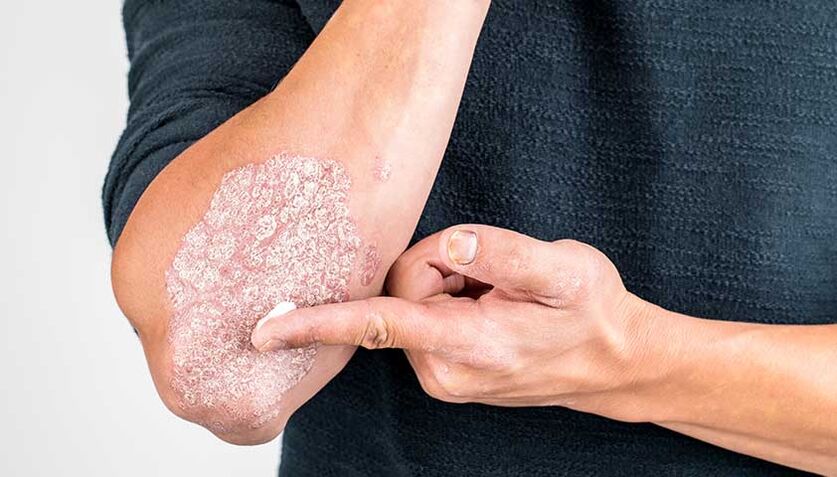
Mild psoriasis is often treated with topical ointments and creams.
Moderate to severe psoriasis may require systemic treatment - in the form of classic immunosuppressive and genetically modified biological drugs in the form of tablets or subcutaneous injections. They have a pronounced effect, but require careful examination before use.
Systemic glucocorticosteroids for psoriasis are contraindicated and can only be prescribed by a doctor in certain (extremely severe) situations and in a hospital setting. Otherwise, such treatment can lead to a significant worsening of the condition.
Psoriasis is also treated with phototherapy: ultraviolet light of a certain spectrum is directed at the plaques. Many physical therapy offices have special lamps for this type of treatment.
The most modern and effective way to treat psoriasis is monoclonal antibodies (biological therapy with genetic engineering). These drugs can block some stages of the inflammatory response, for example, certain cytokines CytokinesProteins, produced mainly by protective cells of the immune system, cause inflammation and plaque growth in psoriasis.
Prevention of psoriasis
There is no specific prevention that could prevent the development of psoriasis.
In general, it is recommended to lead a healthy lifestyle: giving up alcohol and smoking, exercise and a healthy and balanced diet.
People whose relatives have psoriasis should take care of their skin: moisturize it regularly, avoid hypothermia, prolonged exposure to the sun, and avoid visits to solariums. Tattoos are not recommended if you have a hereditary predisposition to psoriasis.
Forecast
Psoriasis is a chronic pathology, like all autoimmune diseases. It is impossible to completely cure psoriasis.
However, timely and properly selected treatment can allow the patient to achieve long-term remission - a period of asymptomatic disease.
Frequently asked questions
How is psoriasis transmitted?
Psoriasis is not contagious. It is an autoimmune disease – it occurs when a person's immune system malfunctions and mistakenly attacks skin cells. The disease has a hereditary (genetic) predisposition, which means that it can be inherited.
How does psoriasis manifest itself?
In most cases of psoriasis, large red, scaly plaques appear on the surface of the skin. They can be very itchy and even painful. Most often, psoriatic patches appear on the elbows, knees, trunk and scalp.
Which doctor treats psoriasis?
A dermatologist treats psoriasis.
Can people with psoriasis be accepted into the army?
With a mild form of psoriasis, they can be assigned category B - "limited suitability". A recruit with moderate or severe psoriasis may be considered unfit for military service. In each specific case, the decision is made individually during the medical examination.


















